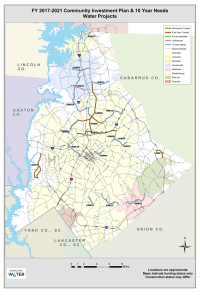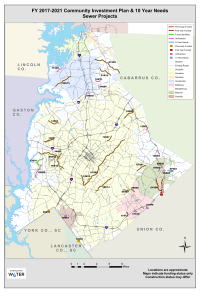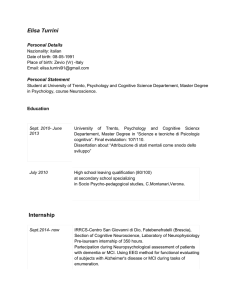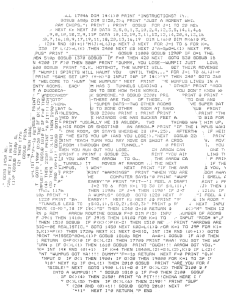ActionPotentialPropagation.pptx
advertisement
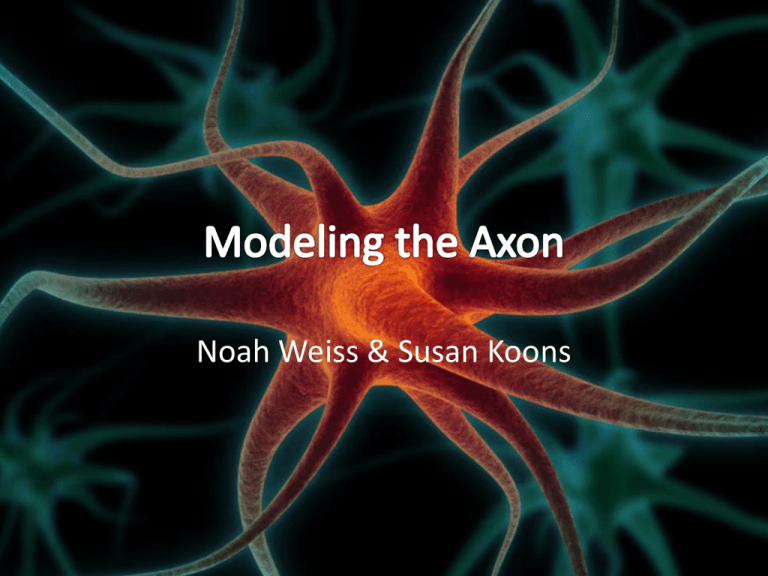
Noah Weiss & Susan Koons Neuroscience: 3ed Neuroscience: 3ed Neuroscience: 3ed Neuroscience: 3ed • Resistors: Linear or non-linear F(V,I)=0 V=IR I=f(V) V = h(I) dVC IC • Capacitors: C dt dA VA • Pumps: dt • Kirchhoff’s Current Law: The principle of conservation of electric charge implies that: The sum of currents flowing towards a point is equal to the sum of currents flowing away from that point. i2 i3 i1 i1 = i2 + i3 • Kirchhoff’s Voltage Law The directed sum of the electrical potential differences around any closed circuit must be zero. (Conservation of Energy) R2 R1 VR1 + VR2 + VR3 + VC =0 R3 • Neurons can be modeled with a circuit model – Each circuit element has an IV characteristic – The IV characteristics lead to differential equation(s) • Use Kirchhoff’s laws and IV characteristics to get the differential equations dV • Solve for I and use C C I C C dt • To find I use the current law: A A I A 1 2 A – Additionally, define the absolute current IS A1 A2 – Assume a linear resistor with (small) resistance γ in series with the pumps • Use Kirchhoff’s laws to get: dV C C I I Na f K VC EK I A ext dt I S VC I A I A I S I A VC I A VC ENa hNa I Na I Na • Assume the “N” curve doesn’t interact with the “S” curve – All three parts of “N” are within primary branch of “S” – Also, let ε = 0: dV C C I I Na f K VC ext dt I S VC I A I A I S I A VC I A I Na g Na VC ENa EK I A I V K Na • Substitute the 4th equation into the 1st dV C C I g Na VC ext dt I S VC I A I A I S I A VC I A ENa f K VC EK I A • Nullclines: Set the derivatives equal to zero – Nontrivial nullcline in the 2nd and 3rd equations are same – Re-arrange and obtain the following: Nullcline equations I Iext g Na VC A V I A C ENa f K VC EK • Let Iext 0 – Analyze the nullclines: vector field directions – Assume C<<1: singular perturbation – IA nullcline intersects VC nullcline in primary IA branch IA nullcline VC nullcline Vc • Increase Iext to shift the VC nullcline upward • To get an action potential: • The “N” curve has 2 “knee” points at V1 and V2 Nullcline equations I Iext g Na VC A V I A C ENa f K VC EK 0, if VC V1 f K VC G1VC G2 G1 VC V1 if V1 VC G2 G1 V2 V1 if V2 VC • The “S” curve is merely linear by assumption (i.e. gNa is constant) • Some algebra shows that Iext must satisfy: Iext >= VC 1 gNa G2 g Na ENa V1 G2 G1 with VC V1,V2 V2 dV C V E I C I I f C ext Na K K A dt V I I I A S C A V I I I S A C A I I V E h Na Na Na Na C Inside the cell Outside the cell • Recall the equations for one node: – There is no outgoing current • Consider a second node that is not coupled to the first node – It should have the same equation (but with different currents) dV C C I I Na f K VC EK I A ext dt dI A I V I S C A dt dI S I A VC I A dt dI Na VC ENa hNa I Na dt 2 C 2 dI A dt dI 2 S dt dI 2 Na dt C dV 2 I 2 f 2 V 2 E 2 I 2 Iext Na K C K A dt I S2 VC2 I A2 I A2 VC2 I A2 2 h2 I 2 VC2 ENa Na Na • Couple the nodes by adding a linear resistor between them 1 VC2 VC1 dVC 1 1 1 1 Iext I Na f K VC EK I A C R1 dt 1 dI A I 1 V 1 I 1 S C A dt 1 dI S I 1A VC1 I 1A dt 1 dI Na VC1 E1Na hNa I 1Na dt dV 2 VC2 VC1 2 2 2 2 C C I Na f K VC EK I A R1 dt dI 2 A I 2 V 2 I 2 S C A dt dI 2 S I 2 V 2 I 2 A C A dt dI 2 Na V 2 E 2 h I 2 Na Na Na C dt • This is the general equation for the nth node • In and out currents are derived in a similar manner: dVCn n1 I n f V n E n I n I n C Iout in Na K C K A dt dI An I Sn VCn I An dt dI Sn I An VCn I An dt n dI n h In Na VCn ENa Na Na dt I if n 1 ext n1 n Iout V V n1 C C if n 1 n 1 R n1 n VC VC if 1 n N Iinn Rn if n N 0 C=.1 pF Forcing current C=.1 pF C=.1 pF C=.1 pF C=.01 pF C=.01 pF C=.7 pF C=.7 pF (x10 pF) (ms) (x10 pF) (ms) (x100 mV) (x100 mV) The Importance of Myelination- Myelinated Axon (ms) • Myelination matters! Myelination decreases capacitance and increases conductance velocity • If capacitance is too high, the pulse will not transmit • First model that shows a pulse that travels down the entire axon without dying out
